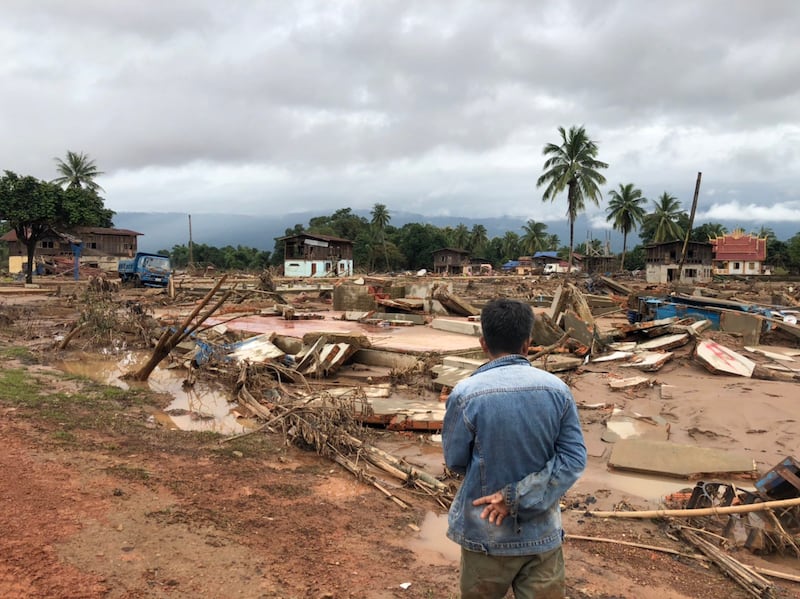The company responsible for Laos’ worst ever dam collapse more than three years ago announced last week that its rebuilt dam would begin releasing water, scaring downstream residents, including survivors of the disaster.
On the night of July 23, 2018, billions of cubic feet of water from a tributary of the Mekong River poured over a collapsed saddle dam at the Xe Pian Xe Namnoy (PNPC) hydropower project following heavy rains in Laos’ Champassak province.
The disaster wiped out all or part of 19 villages, leaving 71 people dead and displacing 14,440.
Since then, a new saddle dam has been completed, and some of the survivors have settled back into areas downstream.
Many of the returned residents were shaken on Friday by PNPC’s announcement that it would start discharging water the next day, forcing many of them to temporarily uproot their lives once again to get to higher ground.
“Oh, we were panicking and we were so worried that the dam would collapse again. They should’ve warned us at least one week earlier,” a resident of Tam Mayor Village, one of four villages downstream in Sanamxay district, home to many survivors of the 2018 disaster, told RFA’s Lao Service.
“Many people didn’t know anything about the warning because they weren’t at home. Most of them were at farms or rice fields,” said the source, who requested anonymity for security reasons.
“As soon as we received the warning, we moved immediately to the hills nearby,” another survivor told RFA.
A third downstream resident told RFA that they did not get the warning from the PNPC but did get a warning from the provincial authorities.

An Attapeu province official confirmed that the PNPC released water Friday.
“They, the company, are working on some repairs to the saddle dam. The water discharge will last for a week. The river water level is rising about a meter,” the official said.
The official said that PNPC called local and provincial authorities to inform residents who live close to the Xe Pian River to move to higher ground.
An employee of the PNPC told RFA that the company was not ready to explain why the dam released water suddenly.
“We can’t say anything much right now. We’re in the process of inspecting. The management team may or may not reveal information,” the PNPC employee said.
The problem could be related to a malfunction in a flood gate, Brian Eyler, co-lead of the Mekong Dam Monitor project run by the Stimson Center think tank in Washington, told RFA. Satellite imagery suggests the gate has been spilling water since March 25 through at least March 27, he said.
“The flow rate from the flood gate does not appear to pose an immediate threat to downstream communities, but the reservoir is losing water due to the equipment malfunction. Until the gate is closed, the dam company will incur significant income losses to current and future hydropower production,” Eyler said.
“This saddle dam was built to replace the saddle dam that burst in 2018. Typically saddle dams, which are used to shore up and reinforce the side of a reservoir, do not have flood gates, but I assume the dam operator installed a flood gate in the rebuilt saddle dam to mitigate risk if conditions similar to the 2018 dam burst were to appear to happen again,” he said.
According to records from RFA’s Lao Service, the new saddle dam D was completed in October 2019 and is located one kilometer north of the old one.
The Xe Pian-Xe Namnoy Dam can now produce 410 MW of electricity, 90 percent of which is sold to companies in Thailand.
The $1 billion dam was developed by South Korea’s SK Engineering and Construction and Korea Western Power, Thailand’s Ratch Group and the Lao power state enterprise, Electricite du Laos.
Laos has staked its future on power generation in a controversial bid to become the “Battery of Southeast Asia,” exporting electricity from more than 50 large and small-scale dams on the Mekong River and its tributaries.
Though the Lao government sees power generation as a way to boost the country’s economy, the projects have faced criticism because of their environmental impact, displacement of villagers and questionable arrangements.
Translated by Max Avary. Written in English by Eugene Whong.
